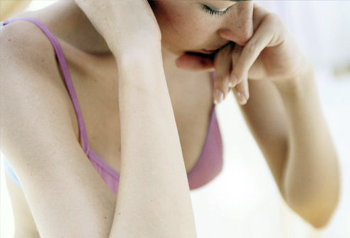Yeast Infections
 Overview
Overview
Vaginal yeast infections are also known as thrush and will occur in an estimated 75 percent of all women at some point during their life. This condition is among the most common that physicians see for women with infections.
Most of the billions of organisms in the body are essential to a person's good health. One such normally harmless organism is the fungus called Candida albicans. In a healthy body this is kept in check. When an imbalance occurs, levels of bacteria which are beneficial fall and organisms such as Candida albicans are allowed to thrive. When this particular fungus takes control, the result is a vaginal yeast infection.
Symptoms
One of the most obvious symptoms of a yeast infection is a white, sticky discharge from the vagina. A yeasty smell will usually give away the condition. Soreness and itching during urinating and intercourse are other signs.
Thrush can also occur when the person is under a great deal of stress or is run down. Taking antibiotics can lead to this condition, as well as taking hormone medications such as the Pill or HRT. Pregnant women are especially vulnerable to yeast infections.
Causes
As noted above, yeast infections are caused by a group of yeast-like fungi called Candida. Everyone has a certain amount of Candida thriving on them and in them, but not every person will develop a yeast infection.
Yeast live on moist areas of the body, such as the vagina and the lining of the mouth. Typically they cause no problems, but when they overgrow an infection is the result. While the vagina is the primary site for these infections, a yeast infection can also occur in the mouth, on the skin, and in the respiratory tract.
This type of infection has become more common because of the use of medications which spur an overgrowth of yeast. The drugs responsible for this are steroids, antibiotics and birth control pills.
Diagnosis
It is important to have a proper diagnosis by a health care professional so proper treatment can be started. Before visiting the local pharmacy for an antifungal medication, be sure the diagnosis is correct. Some of the symptoms of yeast infection are similar to more serious vaginal conditions.
Conventional Treatments
Among the conventional treatments available are:
- Oral treatments - These are available in single-doses which contain fluconzaole (an antifungal). While the benefit is taking just one dose, side effects can include nausea, diarrhea, abdominal pain, rashes and flatulence.
- Creams and Pessaries - One of the easiest ways to overcome a vaginal yeast infection is to use a topical treatment. An antifungal cream can be rubbed onto the vagina, or a course of pessaries (which are inserted into the vagina) can be used. Be sure to use up all of the medication so an overgrowth of yeast does not occur as soon as treatment stops.
Natural Treatments
Diet is a good place to start in treating a yeast infection. Since the body already has an overload of yeast, avoid foods that contain yeast (from breads to champagne). The levels of good bacteria in the vagina are estrogen dependent. Therefore, it is essential to get the hormones back into balance by following a hormone-balancing diet. Cut out all forms of sugar in foods and drinks. Avoid fruit juices while suffering from a yeast infection. Sugar helps bacteria and yeast thrive, so juices and sugar will hamper a successful fight to be healthy.
Supplements
A multi-vitamin with minerals can be beneficial during this type of infection. Other supplements to take include:
- Beta-carotene - Women with thrush are typically deficient in this nutrient.
- Zinc - This supplement is a potent immunity booster. Many woemn with thrush have a zinc deficiency.
- FOS - Fruits and vegetables contain a water-soluble fiber called fructooligosaccharides, or FOS. FOS is a prebiotic, a food source that helps promote the growth of friendly bacteria in the body.
Herbs
Take 300 mg daily of each of the following herbs in capsule form:
- Echinacea - This herb is proven to reduce the number of attacks of Candida infection in women who are prone to this condition.
- Goldenseal - This herb is known to activate the body's white blood cells, giving a person potent, immunity-boosting powers.
- Pau D'arco - This herbal remedy has an inner bark with very potent antifungal properties. Whole-bark is better than extracted compounds with this herb.
Other Natural Treatments
Some easy home treatments include:
- Adding a handful of salt to the bathwater can help soothe irritation and itching.
- Hanging loose by avoiding tight, manmade fibers in clothing is helpful. Wear cotton underwear and avoid nylon tights or pantyhose.
- Using sanitary napkins instead of tampons while battling thrush will help healing.
- Avoiding perfume such as that in soaps or bubble baths is beneficial.
- Checking out your sexual partner to ensure he does not have thrush as well is essential. If the partner has thrush that goes untreated, the condition gets passed back and forth.
References
- Bratman, S. The Alternative Medicine Ratings Guide: an expert panel rates the best treatments for over 80 conditions, Prima Health A Division of Prima Publishing (1998)
- Brown, L. Alternative Medicine, NTC/Contemporary Publishing (1999)
- Canas, M. et al. (2006). Women's health. Barcelona, Spain : Rebo
- Glenville, M. (2010).The natural health bible for women : the complete guide for women of all ages.London : Duncan Baird Publishers
- Deepak Chopra, M.D. Alternative Medicine: The Definitive Guide, Celestial Arts (2002)
- Jarvis, S.(2009).Women's health for life : medical advice you can trust : symptoms, treatment, prevention. London : Dorling Kindersley
- Servan-Schreiber, D. The Encyclopedia of New Medicine: Conventional & Alternative Medicine For All Ages, Rodale International Limited (2006)
Posted in Yeast Infections
Ask a Question Or Join a Discussion


